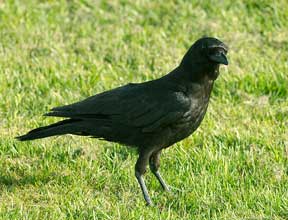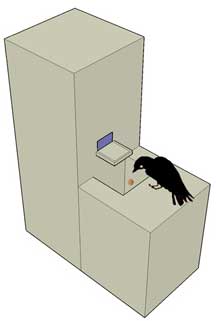 The Nature of Cedar Mill The Nature of Cedar Mill
Crows in Suburbia
by John Ramey
Scientists have noticed that crows are becoming more comnmon in suburban and urban environments. It's thought that the high intelligence and adaptabilty of this species have allowed them to learn new behaviors to take advantage of human environments.
American crows (Corvus brachyrhynchos) are omnivores and they both hunt and scavenge for food. So both human refuse and the smaller scavengers that feed on it are food for crows. Add road-kill and insects, and small birds and rodents that inhabit our parks, fields and gardens and the crows are eating well. Those you see hopping around on your lawn are probably looking for worms, insects or whatever comes along. I know one local homeowner who gets rid of the carcasses that her cat brings as gifts by flinging them on the roof for the crows who happily dispose of them.
Crows are also safer in the environments we’ve built for ourselves. People are not shooting guns at them, for one thing. Other than humans, their main predators are large hawks and owls, which have a diminished presence near dense human populations. In suburbs with enough wooded areas to maintain populations of owls (such as Cedar Mill), it is thought that elevated nocturnal light levels help to protect crows from those night hunters.
They’ve learned to use roofs and eaves in urban areas for roosting, although trees are traditional and preferred. Consequently the more dominant couples mate in the suburbs where there are more trees and a greater variety of food sources. The crows we see in the heart of Cedar Mill will most likely be nesting in trees nearby (as the crow flies).
Crows can live as long as thirty years in the wild. They are very social and form working relationships that last many years. The young will spend a year or two with their parents before heading out on their own. During that time they will actively help feed, protect and socialize subsequent hatchlings.
Because their socialization is so complex, long lasting and integral to their survival it is a very bad idea (as well as illegal) to take young crows as pets. As fledglings they can spend up to a week on the ground as they learn to fly. They may also be almost as large as their parents. Well-meaning people will sometimes believe that they are injured adults, or mistake the attentions of the “extended family” as attacks and take them in for protection, with idea of letting them go in a year or two. That bird has little chance of surviving, having missed its most important opportunity to “connect” with other crows.
 Cats and dogs are way too large for crows to hunt. However, if they perceive that their fledglings are in danger they may well attack them. If there are a number of crows around, these attacks can be group efforts, called “mobbing.” The intent is not to harm but to cause confusion and fear, and so drive the threat away—another good reason to stay away from fledglings. Cats and dogs are way too large for crows to hunt. However, if they perceive that their fledglings are in danger they may well attack them. If there are a number of crows around, these attacks can be group efforts, called “mobbing.” The intent is not to harm but to cause confusion and fear, and so drive the threat away—another good reason to stay away from fledglings.
How clever can crows be? Inventor Josh Klein decided to see if he could teach them to use a crow "vending machine." The device trained them to put metal discs that he had scattered around into a box for a reward of peanuts. When he withheld the discs, the crows flew off and returned with coins found on village streets to exchange for their reward. Klein has been working on a new device that would reward them for depositing trash!
|
